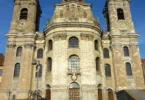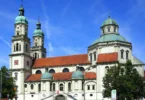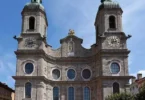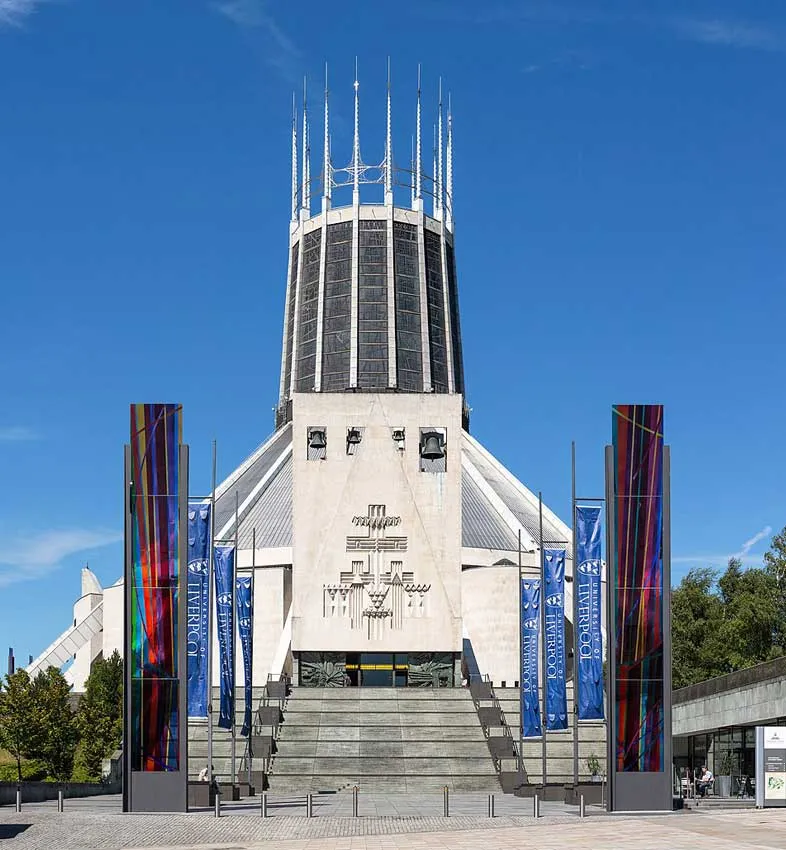
Introduction
Liverpool Metropolitan Cathedral, officially known as the Metropolitan Cathedral of Christ the King and locally nicknamed “Paddy’s Wigwam”, is the seat of the Archbishop of Liverpool and the mother church of the Roman Catholic Archdiocese of Liverpool in Liverpool, England. The Grade II Metropolitan Cathedral is one of Liverpool’s many listed buildings.
The cathedral’s architect, Frederick Gibberd, was the winner of a worldwide design competition. Construction began in 1962 and was completed in 1967. Earlier designs for a cathedral were proposed in 1933 and 1953, but none were completed.
The spirit of the Metropolitan Cathedral is deeply embedded in its fascinating history, a tale of determination, tenacity and conviction that, despite the odds, saw architects, builders, craftsmen, residents and church elders work together to fulfill their holy ambition. To create a place of special, deeply spiritual resonance for all who use it.
The striking design of the present Cathedral is actually the fourth attempt by the Catholic Church in the North West of England to build a mother church for the Liverpool diocese and the culmination of a story that stretches back over a century.
History - Pugin's Design

The First Attempt to Design a Cathedral for Liverpool
In pre-Reformation days Liverpool had no Cathedral. It belonged for several centuries to the Diocese of Lichfield, or Lichfield and Coventry, until, at the Reformation in the time of Henry VIII, it came under the newly constituted Diocese of Chester. After the Reformation the Roman Catholic religion was proscribed and could only be practised in secret. It was not until the restoration of the hierarchy in 1850 that the normal structure of dioceses was re-established for Catholics. The first Bishop of the new diocese of Liverpool was George Brown, until then Vicar Apostolic or administrator of the Lancashire District of the Catholic Church in England. His Co-adjutor or Assistant Bishop was Alexander Goss.
As a young priest Fr Goss had been a teacher and subsequently Vice-President at the junior seminary for the training of priests which had been set up in 1845 within the walls of one of Liverpool’s older mansions, San Domingo House in a road named after it, St Domingo Road. Built by a successful merchant, this stood on a ridge in Everton, commanding a view of the North docks, the River Mersey and the Wirral peninsula.
The Catholic population of Liverpool increased dramatically following the Irish potato famine in 1847, and the restoration of the hierarchy gave Catholics a new status and feeling of confidence. It was no surprise, then, that Co-adjutor Bishop Goss saw the need for a Cathedral. He also saw the ideal site in the grounds of the College at Everton.
The commission to design a Catholic Cathedral for Liverpool was entrusted in 1853 to Edward Welby Pugin (1833-1875), son of Augustus Welby Pugin, foremost architect of the Gothic Revival, who had died in the previous year. The design was a bold one dominated by a massive central steeple. Within three years a usable portion of the building was completed in the form of the Lady Chapel, with an entrance built into the surrounding wall of the College. There it stood for over a century, serving as the church of the local parish of
Our Lady Immaculate until the 1980s, when, weather-beaten and structurally unsafe, it was demolished.
Meanwhile the attention of the diocese was concentrated on more pressing needs parish churches, schools and orphanages as the Catholic population increased apace and the completion of the cathedral was shelved.
Lutyens' Design
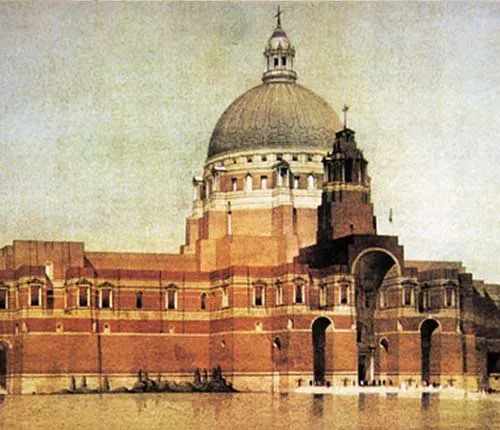
The Second Attempt to Design a Cathedral for Liverpool
Following the purchase of the 9-acre (36,000 m2) former Brownlow Hill workhouse site in 1930, Sir Edwin Lutyens (1869–1944) was commissioned to provide a design which would be an appropriate response to the Giles Gilbert Scott-designed Neo-gothic Anglican cathedral then being built further along Hope Street.
Lutyens’ design was intended to create a massive structure that would have become the second-largest church in the world. It would have had the world’s largest dome, with a diameter of 168 feet (51 m) compared to the 137.7 feet (42.0 m) diameter on St. Peter’s Basilica in Vatican City. Building work based on Lutyens’ design began on Whit Monday, 5 June 1933, being paid for mostly by the contributions of working class Catholics of the burgeoning industrial port. In 1941, the restrictions of World War II wartime and a rising cost from £3 million to £27 million (£1.42 billion in 2021), forced construction to stop. In 1956, work recommenced on the crypt, which was finished in 1958. Thereafter, Lutyens’ design for the cathedral was considered too costly and was abandoned with only the crypt complete. The restored architectural model of the Lutyens cathedral is on display at the Museum of Liverpool.
Scott's Reduced Design

The Third Attempt to Design a Cathedral for Liverpool
Dr William Godfrey, himself Liverpool born, became Archbishop of Liverpool in 1953. It fell to him to make the decision to reduce the project to realistic proportions.
Adrian Gilbert Scott (brother of Giles Gilbert, the architect of the Anglican Cathedral) was commissioned to scale down the Lutyens plans, keeping the massive dome feature, but with a budget of some £4,000,000. But the project meet with heavy criticism and before work could begin Archbishop Godfrey had been translated to the See of Westminster and John Carmel Heenan succeeded as Sixth Archbishop of Liverpool. Archbishop Heenan soon recognised that the mighty project was unachievable and he decided to scrap the plans and to start again.
Gibberd’s Realisation

The Fourth Attempt
Even more drastic measures, thought Dr Heenan, were necessary if the Catholics of Liverpool were to achieve the realisation of Archbishop Downey’s dream slogan A Cathedral in our time. The problem was to be thrown open to competition.
Architects throughout the world were invited in 1960 to design a Cathedral for Liverpool which would relate to the existing Crypt, be capable of construction within five years, cost at the current prices no more than £1,000,000 for its shell, and most important of all, express the new spirit of the liturgy then being radically reformulated by the Second Vatican Council. Of 300 entries from all over the world, Sir Frederick Gibberd’s (1908-1984) design was chosen, and building began in October 1962. A Pathé newsreel showed stages of the building process. Less than five years later, on the Feast of Pentecost, 14 May 1967, the completed Cathedral was consecrated. The Papal Legate at the consecration service, most appropriately, was His Eminence John Carmel Cardinal Heenan, Archbishop of Westminster, who had been succeeded as Archbishop of Liverpool three years earlier by George Andrew Beck. The long waiting was suddenly over.
Architecture

The competition to design the cathedral was held in 1959. The requirement was first, for a congregation of 3,000 (which was later reduced to 2,000) to be able to see the altar, in order that they could be more involved in the celebration of the Mass, and second, for the Lutyens crypt to be incorporated in the structure. Gibberd achieved these requirements by designing a circular building with the altar at its centre, and by transforming the roof of the crypt into an elevated platform, with the cathedral standing at one end. The construction contract was let to Taylor Woodrow.
The cathedral was built quickly and economically, and this led to problems with the fabric of the building, including leaks. A programme of repairs was carried out during the 1990s. The building had been faced with mosaic tiles, but these were impossible to repair and were replaced with glass-reinforced plastic, which gave it a thicker appearance. The aluminium in the lantern was replaced by stainless steel, and the slate paving of the platform was replaced with concrete flags.
Exterior
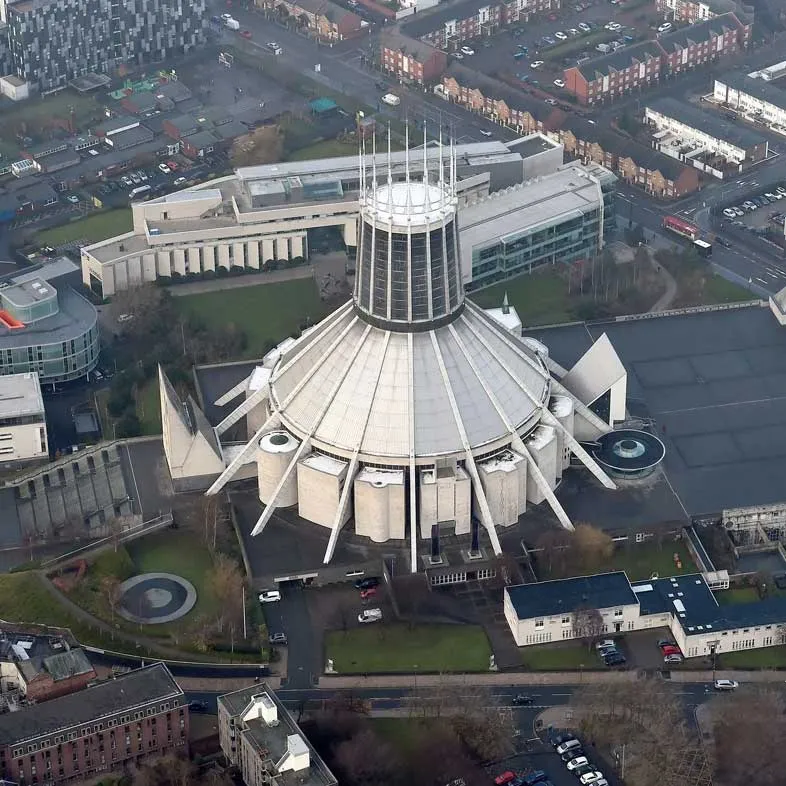
The cathedral is built in concrete with a Portland stone cladding and an aluminium covering to the roof. Its plan is circular, having a diameter of 195 feet (59 m), with 13 chapels around its perimeter. The shape of the cathedral is conical, and it is surmounted by a tower in the shape of a truncated cone. The building is supported by 16 boomerang-shaped concrete trusses which are held together by two ring beams, one at the bends of the trusses and the other at their tops. Flying buttresses are attached to the trusses, giving the cathedral its tent-like appearance. Rising from the upper ring beam is a lantern tower, containing windows of stained glass, and at its peak is a crown of pinnacles.
The entrance is at the top of a wide flight of steps leading up from Hope Street. Above the entrance is a large wedge-shaped structure. This acts as a bell tower, the four bells being mounted in rectangular orifices towards the top of the tower. Below these is a geometric relief sculpture, designed by William Mitchell, which includes three crosses. To the sides of the entrance doors are more reliefs in fibreglass by Mitchell, which represent the symbols of the Evangelists. The steps which lead up to the cathedral were only completed in 2003, when a building which obstructed the stairway path was acquired and demolished by developers.
A much smaller version of the cathedral, also designed by Sir Frederick Gibberd, was constructed in 1965 as a chapel for the former De La Salle College of Education, Middleton, Lancashire, a Catholic teacher-training college. The site is now occupied by Hopwood Hall College, a further education college of the Borough of Rochdale and the chapel may still be seen.
Interior
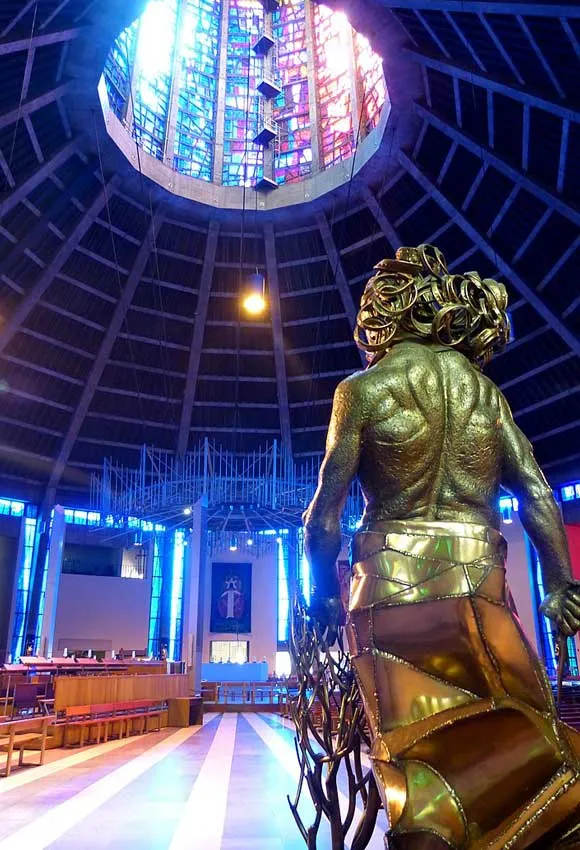
The focus of the interior is the altar which faces the main entrance. It is made of white marble from Skopje, North Macedonia, and is 10 feet (3 m) long. The floor is also of marble in grey and white designed by David Atkins. The benches, concentric with the interior, were designed by Frank Knight. Above is the tower with large areas of stained glass designed by John Piper and Patrick Reyntiens in three colours, yellow, blue and red, representing the Trinity.
The glass is 1 inch (3 cm) thick, the pieces of glass being bonded with epoxy resin, in concrete frames. Around the perimeter is a series of chapels. Some of the chapels are open, some are closed by almost blank walls, and others consists of a low space under a balcony. Opposite the entrance is the Blessed Sacrament Chapel, above which is the organ. Other chapels include the Lady Chapel and the Chapel of Saint Joseph. To the right of the entrance is the Baptistry.
On the altar, the candlesticks are by R. Y. Goodden and the bronze crucifix is by Elisabeth Frink. Above the altar is a baldachino designed by Gibberd as a crown-like structure composed of aluminium rods, which incorporates loudspeakers and lights. Around the interior are metal Stations of the Cross, designed by Sean Rice. Rice also designed the lectern, which includes two entwined eagles. In the Chapel of Reconciliation (formerly the Chapel of Saint Paul of the Cross), the stained glass was designed by Margaret Traherne.
Stephen Foster designed, carved and painted the panelling in the Chapel of St. Joseph. The Lady Chapel contains a statue of the Virgin and Child by Robert Brumby and stained glass by Margaret Traherne. In the Blessed Sacrament Chapel is a reredos and stained glass by Ceri Richards and a small statue of the Risen Christ by Arthur Dooley. In the Chapel of Unity (formerly the Chapel of Saint Thomas Aquinas) is a bronze stoup by Virginio Ciminaghi, and a mosaic of the Pentecost by Hungarian artist Georg Mayer-Marton which was moved from the Church of the Holy Ghost, Netherton, when it was demolished in 1989. The gates of the Baptistry were designed by David Atkins.
The Lutyens Crypt
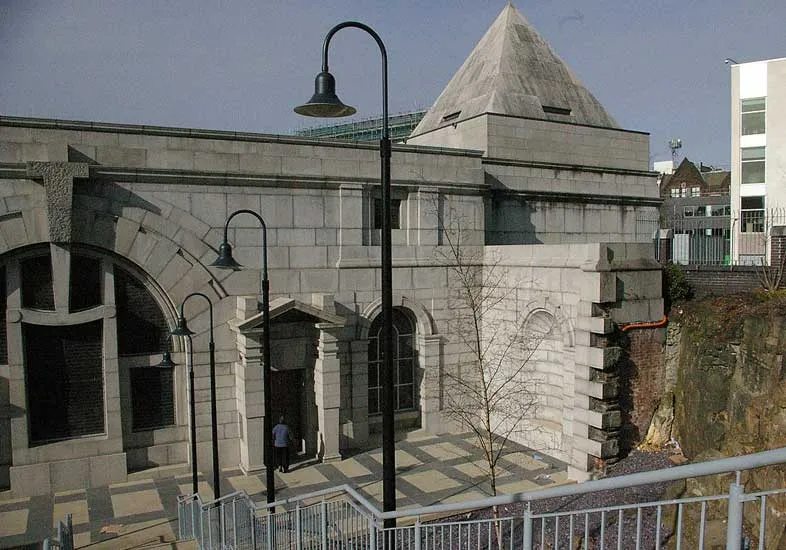
The crypt under Liverpool Metropolitan Cathedral is the only part that was built according to Lutyens’ design before construction stopped due to World War II; in 1962 Frederick Gibberd’s design was built upon the Lutyens crypt. Structurally the crypt is built of brick together with granite from quarries in Penryn, Cornwall.
The beautiful brickwork and vaulted ceilings of Lutyens’ Crypt offer clues to the blueprint of Edwin Lutyens’ grand designs. The Lutyens’ Crypt is no ordinary cathedral crypt; to many in the city this is Liverpool’s third cathedral, a secret spiritual space.
The Crypt is all that remains of an earlier Cathedral for Liverpool, designed by Sir Edwin Lutyens in the 1930’s. Lutyens’ Cathedral was to have a dome bigger than St Peter’s Basilica in Rome, but plans faltered when funds proved hard to find after the Second World War.
The Crypt reveals the scale of Lutyens’ ambition. But, more than just a glimpse at what might have been, it’s a beautiful, atmospheric space in its own right.
The deep purple bricks (all six million of them) and enormous granite dressings hewn from Cornish quarries were chosen to take the weight of the cathedral above. Now, they line vaulted passageways, cool side chapels, graceful halls and concert room.
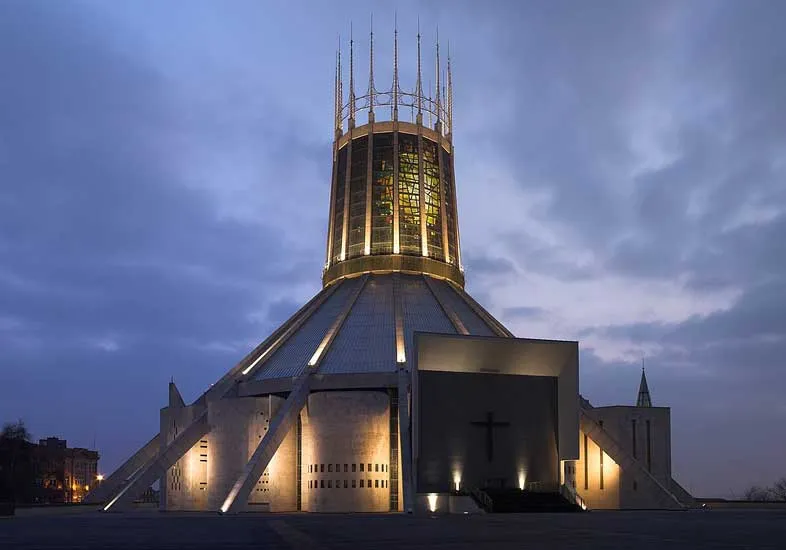
The Treasury
Situated in the Lutyens Crypt, the Treasury contains precious and rare artefacts dating back to pre-Reformation times. Items include processional crosses, chalices, croziers, monstrances and vestments.
The Lutyens Crypt and Treasury is open to visitors Monday to Saturday, 10am – 4pm (last visit at 3.30pm).
Admission is £5 per person, or £12 for a family ticket. Tickets can be obtained from the Cathedral welcome desk.
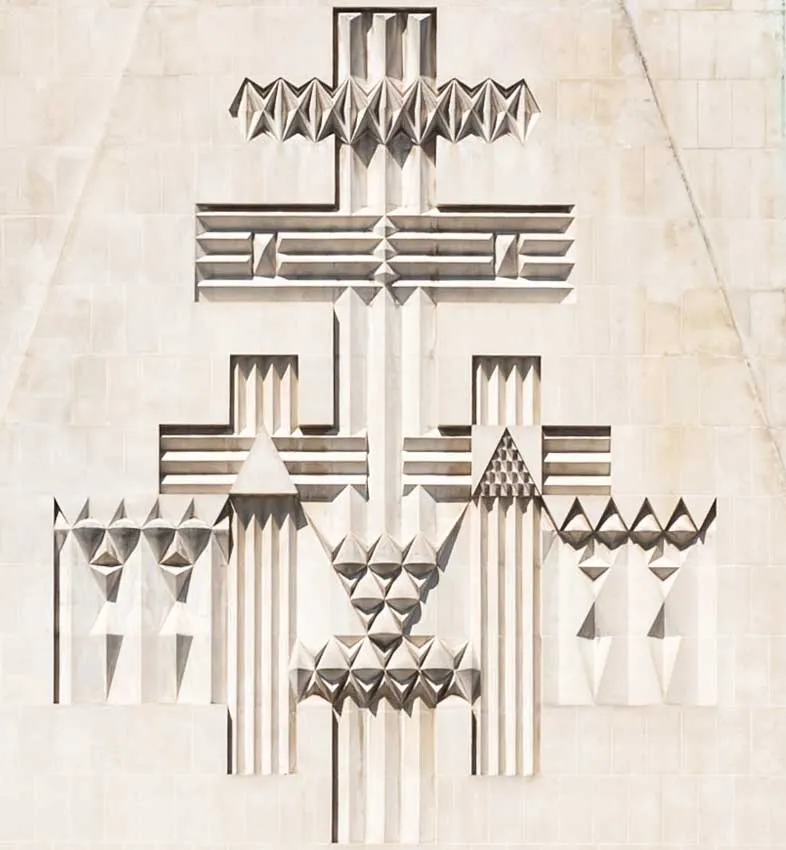
Refurbishment
A £3 million refurbishment of the crypt was completed in 2009 and was officially re-opened on 1 May that year by The Duke of Gloucester. The refurbishment included new east and west approaches, archive provision, rewiring and new lighting, catering facilities, a new chancel, new toilets and revamped exhibitions.
Organ
Built by J. W. Walker and Sons, the organ was completed only two days before the opening of the cathedral in 1967. Made as an integral part of the new cathedral, the architect, Frederick Gibberd, saw the casework as part of his brief and so designed the striking front to the organ. Using decorative woodwork, Gibberd was inspired by the innovative use of the pipes at Coventry Cathedral and the Royal Festival Hall and so arranged the shiny zinc pipes and brass trumpets en chamade to contrast strikingly with concrete pillars which surround the organ.

Specifications
The organ has four manuals, 88 speaking stops and 4565 pipes. It works by way of air pressure, controlled by an electric current and operated by the keys of the organ console; this opens and closes valves within the wind chests, allowing the pipes to speak. This type of motion is called electro-pneumatic action.
Feast Day - 14th May
Annual Feast Day of Liverpool Metropolitan Cathedral, England is celebrated on 14th May.
The present Cathedral was designed by Sir Frederick Gibberd (1908–84). Construction began in October 1962 and less than five years later, on the Feast of Pentecost 14 May 1967, the completed cathedral was consecrated.
Mass Time
Weekdays
Saturdays
Sundays
Church Visiting Time
Contact Info
Cathedral House, Mount Pleasant,
Liverpool, L3 5TQ, United Kingdom.
Phone No.
Tel : +44 151 709 9222
Accommodations
How to reach the Cathedral
Liverpool John Lennon International Airport in Liverpool, England is the nearby Airport to the Cathedral.
Liverpool Lime Street Train Station in Liverpool, England is the nearby Train Station to the Cathedral.



